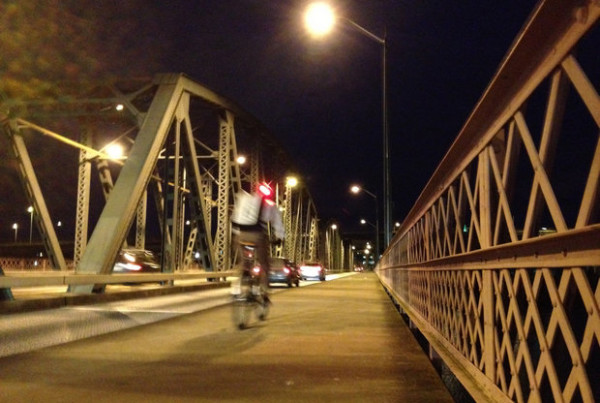LA Weekly: L.A. Bike Plan Troubles
By Ryan Deto Thursday, Aug 18 2011
Mayor Antonio Villaraigosa, if he is still alive, will be 93 years old by the time the new 2010 Bike Plan is supposed to be finished. Some 1,300 of the 1,684 promised miles are still incomplete, and the city is limping along, completing 40 miles of bike lanes per year.
L.A. should be a great biking city in about 35 years. Probably not a good chance Villaraigosa will be able to ride down any of his proposed bike lanes in 2046.
The plan was celebrated as a “milestone” by Los Angeles politicians after its ratification on March 2, and media skepticism about that claim has been absent. News outlets have fallen in line with City Hall’s message of triumph.
But progress has been slow thanks to multiple obstacles. Since Villaraigosa took office in 2005, about 58 miles of bike lanes, paths and bike-friendly streets have been painted. That’s about the same pace of 10 miles of bike lanes per year the city had under his predecessors James Hahn, Richard Riordan and Tom Bradley.
About 334 miles of bike lanes have been created since 1977, during a time when 678 miles were promised. That pace has increased in the past 12 months as city crews installed about 30 miles — well under the touted goal of 40 miles per year, but a jump from previous years.
Villaraigosa claimed recently in an op-ed in the Daily News that “we are putting Angelenos to work by … adding 1,600 miles of new bike paths.” Yet his big office with 207 personal aides is not really paying attention to that project. When the Mayor’s Office was contacted by L.A. Weekly, nobody knew how many bike lanes had been installed during the last year. They had to scramble to come up with the 30-mile count.
While the recent improvement is a bright spot, the Bike Plan faces multiple problems. Don Ward of the Midnight Ridazz cycling group fought hard to make the section of Wilbur Avenue in Northridge where he lives safer for pedestrians and cyclists after several people were killed in car accidents. But the L.A. Department of Transportation (LADOT) almost comically botched the safety plan in June 2010 when it reduced Wilbur Avenue from four car lanes to three and added bike lanes and street parking — without notifying area residents.
Even Ward found out about the new bike lanes only by spotting preliminary spray-painted marks on the road.
Susan Hammarlund, board member of the Porter Ranch Neighborhood Council, sa commuters from Porter Ranch were very upset about losing a busy car lane. So LADOT decided to reconfigure the road — yet again, without getting needed input.
This time, the bike lanes were moved into the gutter — and the speed limit was increased.
“LADOT spent $50,000 to repave the roads and paint lines again, which were just repaved and painted for the addition of bike lanes,” Ward says. “That money could have fixed 9,000 potholes. The road is now more dangerous — even the LADOT engineer admitted that.”
In a press release three months before the Wilbur Avenue fiasco, City Councilman Bill Rosendahl called the new Bike Plan an acknowledgment that bicycles deserve “the same consideration and accommodation that we give to automobiles on our roadways.”
But Ward says the twice-reconfigured bike lanes on Wilbur are unusable because pine needles and cones flood them. “LADOT prioritizes the automobile. That is starting to change, but only because we have gotten so involved politically.”
On July 1, the mayor issued Executive Directive No. 20, which “ensures all City departments and agencies coordinate on bike-related matters to meet the City’s ambitious alternative-transportation goals.”
But, in a stark illustration of Villaraigosa’s disjointed management style, he tweeted his directive in a reply to Lance Armstrong, rather than announcing it to the city departments that would have to alter their operations and attitudes to comply.
“I don’t have time to focus on the political B.S.,” says Ron Durgin, president of Sustainable Streets, a nonprofit group that educates the public on bicycling. “The politicians should be making it easy and transparent for us to follow them.”
When the Weekly contacted Borja Leon, deputy mayor of transportation, he replied with a prepared statement three days later sent from an aide’s email address. It was a reworded version of Villaraigosa’s directive.
Stephen Box, a bike activist featured in the Weekly’s cover story “The Bikeroots,” says the lack of follow-through is rampant at City Hall. “What happened to ‘million trees’ or the green roof initiative? What happened to everything?” Box asks. “This is a city of plans, but if we are not going to implement them, then what does it matter?”
The list of failed initiatives is long, including the mayor’s Clean Tech corridor, his vow to usher in a “transparent” administration and his ethics-in-government initiative. His ethics promise floundered when Villaraigosa was caught accepting $50,000 in unreported free tickets. Charged with violating the city’s code of ethics, he now is drumming up $123,500 (easily covering the $42,000 in fines he owed) from wealthy friends to pay off his lawyers.
Box says comprehensive implementation of the Bike Plan looks just as implausible.
During an April Bike Plan meeting, made up of city staffers who design and create bike lanes, 10 major lanes and paths were proposed. Since then, just 2.61 miles have been completed, according to the LADOT bike blog.
Of 10 city proposals, only a 2.2 mile bike lane on Seventh Street, which will provide Westlake residents access to downtown, is to be constructed later this year. And it was the nonprofit L.A. County Bicycle Coalition, not the city, that did most of the work researching the Seventh Street lane, says that group’s Allison Mannos.
Officials from the Department of Planning said in a conference call that this pace is normal. Claire Bowin, a planner, explains it will “take a year to a year and a half before comprehensive implementation happens, because of things like environmental analysis.”
Case in point: In 2010, a proposed bike path in Cheviot Hills was granted a waiver from obtaining a costly and lengthy state-required Environmental Impact Review (EIR). It was ready to be paved when seven Cheviot Hills homeowners sued.
Villaraigosa’s Bike Plan team tried to install the path behind the backs of local homeowners, says resident Colleen Mason. Cheviot Hills actually backed a bike path — as long as the city could assure that no path would run through their yards. The city settled the lawsuit and is again trying to move ahead without an EIR. “It is a good thing because [City Hall is] involving the homeowners,” Mason says, “but it took a lawsuit to accomplish that.”
Principal city planner Ken Bernstein says, “The message to the public needs to be to hold the city’s feet to the fire in terms of completing this bike plan.”
But Box says, “There is an old culture of insulated contempt at LADOT. They want to increase speed limits and widen streets.”
And Ward says: “Bike culture is growing, but it is hard to move that glacier in the other direction.”
The city accomplished one thing for bikers. On July 20, the City Council passed a new ordinance making it a crime to verbally or physically harass cyclists. They gave bikers more rights, but without many lanes to ride on, will they be able to assert them?

